TUESDAY 24 JUNE
We were due to meet VNF at the first lock at 10.00 on
Tuesday but as we needed to pull into the port in Dannemarie to get water we
left an hour earlier. We were finished quicker than we thought and arrived at
the lock 15 minutes early but it was ready for us so we went straight in. Our
éclusiere, Amelia, introduced herself and took a few details before we got
going. She would see us down the dozen locks to reach Heidwiller our
destination for the day. She used a motor scooter between the locks rather than
a van and because the locks were roughly a kilometre apart, she would be able
to see us down on her own as she would have time to set each lock before we
arrived.
One other boat had gone down earlier in the day and she told
us the éclusier who took them down was her boyfriend. His father, who was also
an éclusier, had encouraged them both to join VNF. She told us that we were the
second of two boats going down during the day and there was only one boat
coming up. She was obviously keen on wildlife as she was taking pictures of
flowers and birds such as a heron that was fishing on the cill at the first
lock and seemed oblivious of our boat being so close.
She told us we’d be passing a group of trees with quite a
few stork nests on. As we went past it, we counted seven nests that had chicks
in.
Most of the lock houses still had what looked like stables and feed stores
alongside and this one had been lovingly prettied up.
The owners had also built a mini ‘lavoir’ at the edge of the
canal.
Karen walked between the final two locks as it looked like
the towpath would be in the shade for some of the way. Here we are going into
the final lock, with Amelia by the control hut, her scooter parked opposite and
Karen waiting to get on the boat.
Once we’d gone through that lock we were in Heidwiller and
moored up on an old quay. The boat that we’d been told would be going up was
just leaving the quay when we arrived, so we had the place to ourselves.
Looking on the web it didn’t seem there was much to see in Heidwiller other than a cave in some woods above the village. As the walk would be under the cool of the trees we decided to have a look. The entry on the web had said
that torches would be required to explore the cave so, for the first time we
could remember, we carried torches on a walk on a bright summer’s day. We found
the cave but didn’t go in very far as the roof was quite low and we felt it
would be a bit foolhardy to go far.
We turned the walk into a circular one to take in the
village itself and found a very modern looking mairie.
Next was the church which was opposite a grand private house
which was the previous mairie but couldn’t find out why it had been relocated.
As we left the village to head back to the canal we passed a promising looking information board as it showed a trail with numbered points. We couldn’t understand how it would have worked as there wasn’t a key to describe what each point was. We had noticed the odd plaque around the place but they didn’t seem to correspond with the numbers on the information board.
On Tuesday we cruised 10 km down 12 locks and saw the one private German boat that was leaving as we moored up at Heidwiller.
WEDNESDAY 25 JUNE
We set off for Mulhouse as soon as Karen got back from her
early morning run. It was quite an uneventful trip with several different éclusiers
seeing us down the locks. This meant we weren’t really able to strike up any meaningful
conversations with any of them unlike the previous day when we had Amelia for the whole trip. We’d heard reports that the pounds were very weedy, but we only
came across weed in three pounds and only one of those could be described as
bad. To put it in context we only had two trips to the weed hatch to remove
weed from the prop. Here is the weed in one of the locks – it could have been a
lot worse.
Éclusiers were doing a good job removing the weed at the
locks and a weed cutter was trawling up and down one pound, dumping the cut weed on
the banks.
We were on the look out for a memorial at the lock at
Illfurth commemorating a plane that crashed during WWII. Karen went in search
of it while the lock was being made ready for us to descend but couldn’t find
it. We just caught sight of it as we left the lock, too late to be able to stop
and see it properly. It marked the spot where a B42 bomber was shot down on its
return from a bombing raid over Germany on 29 January 1944 killing all seven of
the American crew.
The views were really quite different to the steep rocky
hillsides further west on the canal but they were still really pleasant. This
is especially because we thought that approaching Mulhouse it would become very
industrial.
Not only did the éclusiers operate the locks for us they had
to lift two bridges as well. For some reason there were two at each lift bridge
and neither of them operated any of the locks, so it was quite a team that saw
us down to Mulhouse.
Once in the outskirts of Mulhouse we concluded that the industrial
areas must be on the eastern side of the city so we won’t see them until we
leave in a few days’ time. As with all cities there were stretches of permanent
moorings for liveaboards.
The canal ran dead straight through Mulhouse with the railway
line and station on one side and the old town and modern shopping centre on the
other. At 35°C it was one
of our hottest days so far this year and I only managed to get a couple of
photos going through town before my phone switched off because it had overheated.
Along the walls lining the canal were sayings in various
languages written in such a way that the best way to read them was in the
reflection in the water. The trouble was that the boat disturbed the water thus
making them difficult to read. Karen managed to get a picture of this one
written in English before we reached it.
We moored up just as the commercial area became residential again on an old quay that still had mooring rings in place.
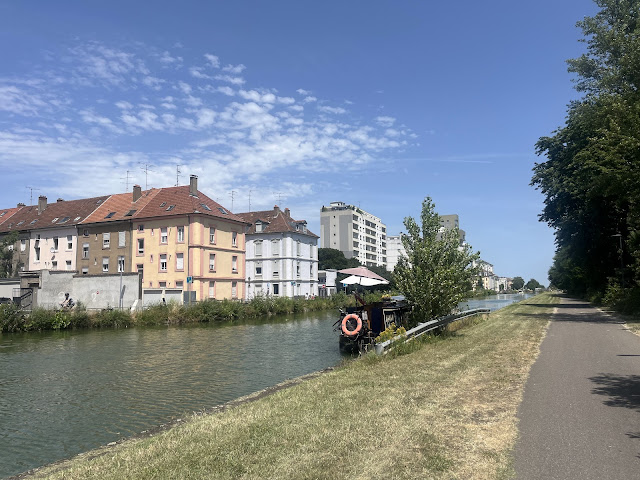
As it was so hot we left sightseeing for another day but did pop into the tourist office to pick up some useful leaflets and, of course, stopped at a bar for an obligatory drink on the way back to the boat.
On Wednesday we cruised 14.5 km, down 11 locks, through two lift bridges and saw no boats on the move.
THURSDAY 26 JUNE
With a partly cloudy day and a drop in temperature I got
some more painting of the roof done before we went on a self-guided historical
tour around the old town in Mulhouse. Having known Mulhouse had a heavily industrialised
past we had built up in our minds a rather run down city but we were clearly
wrong. Here are a few of the sights we saw during the morning.
Place de la Bourse was ringed with buildings following the
same style with arcaded ground floors. This one was built in 1827 for the
Mulhouse Industrial Society and has remained in use by the heads of local
industry since then.
These are some of the buildings on another side of the square.
On a similar subject this is the equivalent of the guildhall
for local winemakers and was built in the 15th century. On the door
lintel are three billhooks, the winemakers’ symbol to portray the tending of
vines.
There were many fine buildings in the Place de la Réunion
which was renamed when the republic of Mulhouse rejoined France in 1798. The
neo-Gothic St-Etienne church, built between 1858 and 1868 stood in the square.
Opposite the church were more pretty buildings, the one to
the left of the building with the tower was the tailors’ guildhall built in
1564.
On another side of the square was the original town hall
built in 1562 and now housing the history museum.
Although the town used to be fortified, the 14th
century Bollwerk tower is all that remains.
After a pleasant lunch in one of the many busy restaurants in old town we walked out of the centre to visit the national motor museum which houses over 450 cars. The cars were collected by the Schlumpf brothers who made their fortune from textiles during the second half of the1900s. They were especially interested in Bugattis of which there were 123 on display. The brothers bankrupted their company to finance their collection and fled to Switzerland to escape any charges. It was really difficult to choose which photos to include so hopefully these show a good cross section of the displays.
 |
| Bugatti Grand Prix cars |
 |
| A selection of Ferraris and Maseratis from the decade of my birth |
 |
| The world’s best supercar according to the Top Gear team - Bugatti Veyron |
 |
| One of two lines of late 19th century cars |
 |
| One of two De Dion-Boutons that competed in the 1907 Peking to Paris race that took 81 days |
The cars were in amazing condition and I’ve picked out this Audi, Bugatti and Alfa-Romeo to complete the set:
Rather than walk back through town to the boat we caught a tram to the railway station and walked from there. Temperatures have been around 30°C for some while but looking at the forecast for next week we’re glad we’re popping back to Flecknoe for a long weekend.
FRIDAY 27 JUNE
With the hot weather continuing it meant Karen had to get
her run in early while I did some painting. Karen ran along the canal to have a
look at the commercial port of Mulhouse and beyond. There were four boats in
when she passed, ranging in length from 110 to 135 metres. As the port is only
a few kilometres from our mooring we’re going to have to be on full alert once
we start cruising with these larger vessels.
Later in the morning we caught a train to Montbéliard to pick up the car where we’d left it at the pleasure port. We had a picnic when we got there and met up with Alastair and Sabine who were also picking up their car from the same car park. We drove back to Mulhouse and left the car the other side of the commercial port Karen had run past in the morning. The port was obviously very active as three of the four boats had gone and there were three more already being unloaded including a gas tanker. This was Primair, the one that hadn't moved.
We had one lock left on this canal where arrangements have to be made in advance with VNF to operate it for us. As we were moving on Saturday I rang them up during the afternoon and agreed to meet at the lock at 10.00. Once through the lock we’ll be on commercial waterways so we did some preparation such as checking that our radio was fully charged and that our apps for tracking the commercials were up to date.
SATURDAY 28 JUNE
We got to the first and only lock of the day on time and the
éclusier had already set it for us. Unusually for this canal, it had a guillotine
bottom gate.
Soon after leaving the lock we passed the entrance to the
old port of Mulhouse which consisted of a couple of kilometres of quays and
wharves. It could only take the small 38 metre péniches so was replaced in the
1960s by the much larger port that Karen ran past the other day that
accommodates boats up to 180 metres in length.
It wasn’t long before we were going through the new port and only one of the boats that we’d seen on a walk the previous day was still there. The other three boats had been replaced and as we approached the area where the liquid gas was unloaded, an empty tanker was pulling out and another full one was already mooring in its place. We couldn’t believe how quickly they started pumping the liquid gas out; it seemed that the pump was in place before the boat had been made secure.
The empty tanker soon disappeared into the distance in front
of us as it was going at least three times as fast as we could travel. The far
end of the port marked the end of the canal du Rhône au Rhin that we’d been on
since joining it from the river Saône on 11th May. It also marked
the start of the canal de Huningue which we now joined. The Rhône au Rhin used
to carry on all the way to Strasbourg but, apart from a stretch at the northern
end, was made redundant when the Rhine from Strasbourg to Basel was canalised. The
13 km canal de Huningue was opened in 1828 and joins Mulhouse to the Rhine near
Basel. In the 1960s it was widened to the European standard Grand Gaberit with
locks 180 metre long by 23 metres wide so the large boats could leave the Rhine
to reach the new port in Mulhouse.
Apart from the fact that we’d seen some commercial traffic another
indicator that we were on a large canal was that there were prominent kilometre
markers. After a few kilometres we
passed an American Sherman tank that had been donated to the Free French army
at the end of WWII. Apparently the gun was pointed ceremoniously at a bridge across
the Rhine that it helped defend during the war.
We moored on a short pontoon in the middle of nowhere, the
nearest village being Hombourg about three km away, making a welcome change
from the previous three nights spent in the city of Mulhouse.
The Black Forest mountains can be seen in the distance in
the picture above and, even though we had clear blue skies all day, the clouds
over the mountains never disappeared. We spent the rest of the day chilling out
around the mooring. The odd commercial came by including a full tanker on its way to the port and one that had
emptied its load at Mulhouse and was on its way to get another load.
 |
| Laden 'Expedition' on its way to Mulhouse |
 |
| An empty 'Fenne' off to pick up another load |
The mooring turned out to be a great spot for butterflies, many of which I couldn’t definitively identify as they tended not to rest for long enough in the heat. The least common varieties we saw were Wood Whites, Clouded Yellows and Pale Clouded Yellows. The only pictures we got that were anywhere near decent enough for the blog were these:
 |
| Essex skipper |
 |
| Chapman’s blue on my sandals (Not found in the UK) |
 |
| Dingy skipper |
On Saturday we cruised 12 km down one lock and during the cruise saw two boats on the move, both commercials.
SUNDAY 29 JUNE
Going out onto the back deck first thing whilst waiting for the kettle to boil I was surprised to see ‘Rembrandt’ passing on its way north to Mulhouse. I say surprised because we hadn’t even heard it coming when laying in bed, probably shows how deep this canal is. The mountains in the background are the Vosges mountains as opposed to the Black Forest mountains that we’ve been seeing in front of us over the last few days as we've been travelling.
Once we’d had our early morning tea and coffee Karen ran back
to Mulhouse to pick up the car and take it further downstream. I set off on the
boat a little while later to meet up with her at the last mooring before we reach
Kembs, which is where we’ll be leaving the boat while we go back to England for nearly a week. When
the canal was widened and deepened in the 1960s a planning approval stipulation
had been to provide semi-circular inlets every so often to create islands.
Boats are not allowed into these inlets and access is not allowed onto the
islands as their purpose was to create wildlife havens, a very forward thinking
approach for those days.
 |
| One of the inlets and islands on the right |
I was soon at the mooring and the timing was perfect as Karen was walking down to it as I arrived so we could tie up safely together. It was another great mooring, being quiet and peaceful with plenty of butterflies about.
We stayed around the boat all day, moving our chairs to keep
in the shade as the sun moved across the sky. As with yesterday there were lots of
butterflies on the wing including another female Chapmans blue that took a great
interest in us. We first spotted it when it landed on Karen’s toes where it
remained off an on for about ten minutes when it then took a liking to our bowl
of peanuts.
Wood whites were in evidence again which was good to see as in the UK they are very rare and not found at many sites. This one had a poorly formed edge to its right forewing.
Being a Sunday we knew it would be quieter on the canal but there were still quite a few commercials that passed during the day, all but one were built for carrying liquid gas.
 |
| Sunday evening on the canal de Hun |
On Sunday we cruised three km through no locks and saw no
boats while we were on the move.
MONDAY 30 JUNE
We had to get the car and boat down to the port at Kembs
during Monday but as it involved eight km of walking we left very early. First
we walked to where Karen had left the car the other day and then drove to the
port to leave it in their car park. We then walked back to the boat and by the
time we reached it we were glad we hadn’t left it any later.
It was an easy cruise down to Kembs which is situated at the end of the canal de Huningue on a section that wasn’t widened and deepened
for the Rhine boats. The wide section finished at Niffer where a couple of
locks drop boats down to the Rhine. A smaller lock for boats less than 85
metres in length and a large lock for the bigger boats. When the large lock was
built during the improvement works, a footbridge was also built across the
canal so sightseers could cross over and see the lock in operation. This is
looking back under the footbridge with the lock entrances to the right on the
far side of it.
Once we were on the old section of canal it felt like we were cruising a canal back in the UK.
The old section was repurposed when the locks at Niffer were
built. The new purpose was to supply water to service the locks. The water is
pumped up from the Rhine the other side of Kembs and flows towards Niffer
meaning we had to travel against the flow. Surprisingly it was quite a strong
flow and we struggled to make headway against it. Sadly, there was a lot of
weed in the water and once the prop was full we ended up being taken backwards
as we lost power. I managed to wedge one end against the bank and Karen jumped
off to hold the boat while I went down the weed hatch. I can honestly say it
was the most weed I’ve ever had to remove. It had almost brought the engine to
a standstill reminding me of the only time that has ever actually happened which was in the middle of Birmingham when what felt like miles of copper wire
got caught around the prop.
Once we were on the move again we soon arrived at the port. Because of our length and the strong current, two guys were on hand to help us spin the boat before mooring up on our allotted space. The restaurant at the port, yet another converted péniche, had closed for lunch when we arrived so we booked for when we return next week and then had a relaxing afternoon in the shade taking advantage of their bar. Tuesday will be spent packing and flying back to the UK for the following six days.
On Monday we cruised 6.5 km, through no locks and didn’t see
any boats.












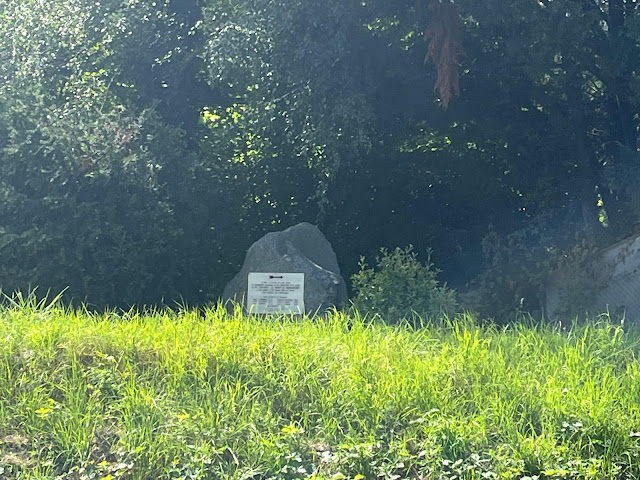

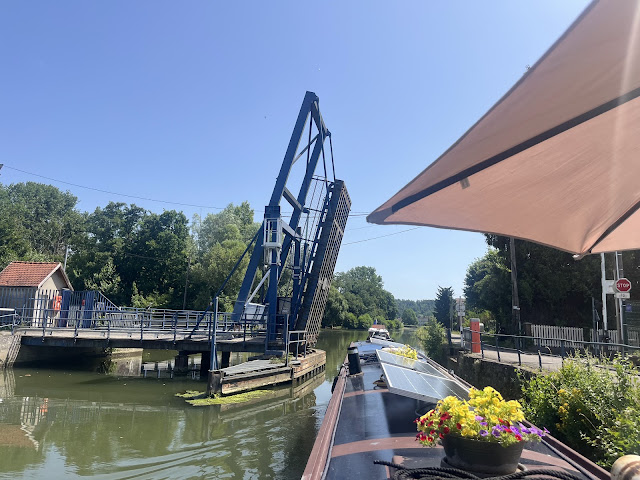










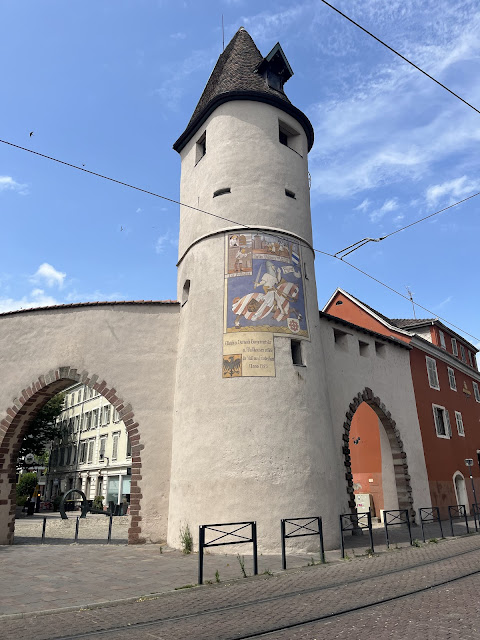


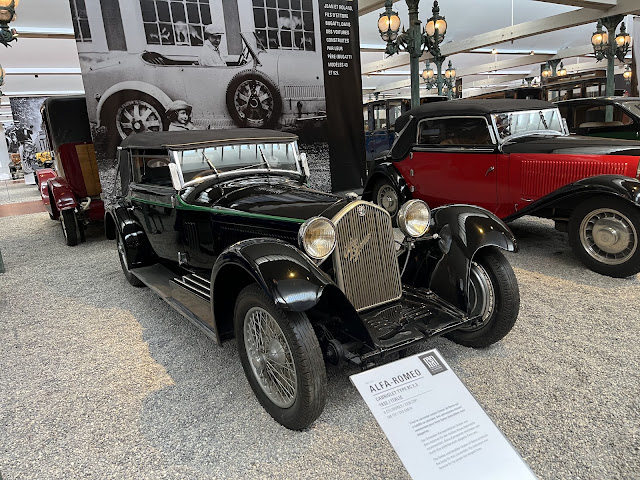












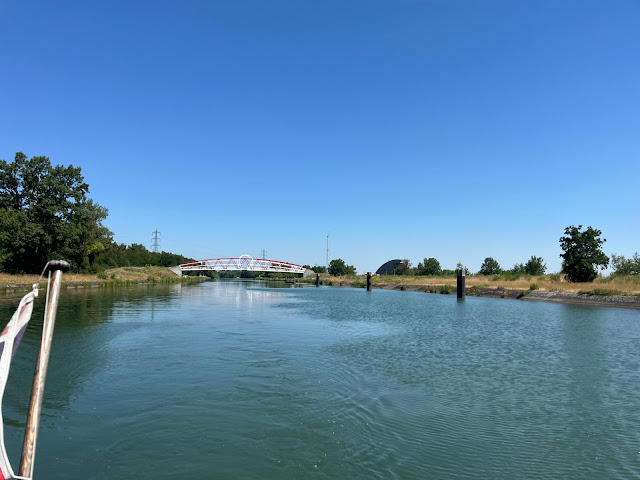
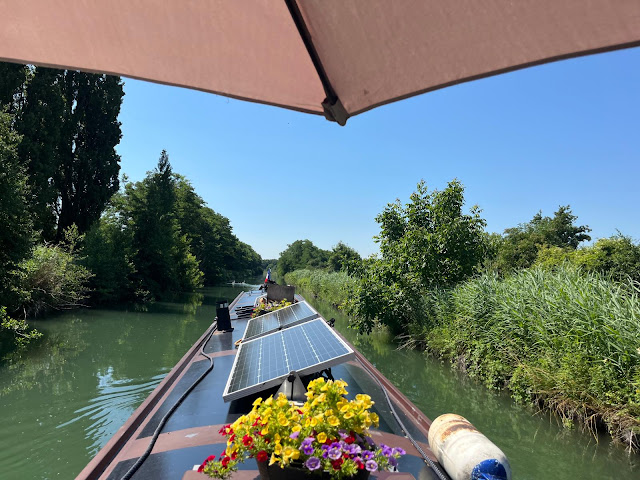
No comments:
Post a Comment